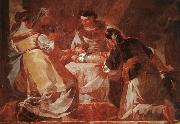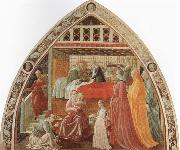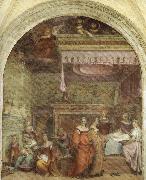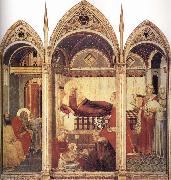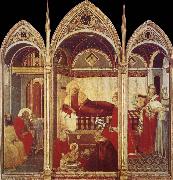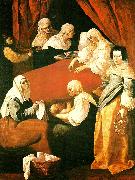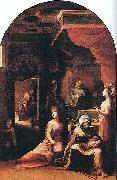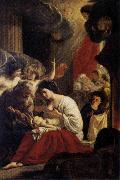Wholesale Oil Painting No Minimum |
|||||||||||
|
|
|||||||||||

|
|||||||||||
|
|
|
||||||||
Francisco de GoyaSpanish 1746-1828 Francisco de Goya Locations was an Aragonese Spanish painter and printmaker. Goya was a court painter to the Spanish Crown and a chronicler of history. He has been regarded both as the last of the Old Masters and as the first of the moderns. The subversive and subjective element in his art, as well as his bold handling of paint, provided a model for the work of later generations of artists, notably Manet and Picasso. Goya married Bayeu's sister Josefa in July 25, 1773. His marriage to Josefa (he nicknamed her "Pepa"), and Francisco Bayeu's membership of the Royal Academy of Fine Art (from the year 1765) helped him to procure work with the Royal Tapestry Workshop. There, over the course of five years, he designed some 42 patterns, many of which were used to decorate (and insulate) the bare stone walls of El Escorial and the Palacio Real de El Pardo, the newly built residences of the Spanish monarchs. This brought his artistic talents to the attention of the Spanish monarchs who later would give him access to the royal court. He also painted a canvas for the altar of the Church of San Francisco El Grande, which led to his appointment as a member of the Royal Academy of Fine Art. In 1783, the Count of Floridablanca, a favorite of King Carlos III, commissioned him to paint his portrait. He also became friends with Crown Prince Don Luis, and lived in his house. His circle of patrons grew to include the Duke and Duchess of Osuna, whom he painted, the King and other notable people of the kingdom. After the death of Charles III in 1788 and revolution in France in 1789, during the reign of Charles IV, Goya reached his peak of popularity with royalty. |
||||||||
|
|
||||||||
Birth of the Virgin
Birth of the Virgin Painting ID:: 1908 |
1771-73 1771-73 |
|||||||
|
|
||||||||
UCCELLO, PaoloItalian Early Renaissance Painter, 1397-1475 Italian painter, draughtsman, mosaicist and designer of stained glass. His work vividly illustrates the principal issues of Florentine art during the first half of the 15th century. Trained within the tradition of the Late Gothic style, he eventually became a leading exponent of the application of linear perspective based on the mathematical system established by Filippo Brunelleschi and Leon Battista Alberti. It is the merging of these two diametrically opposed tendencies that forms the basis of Uccello's style. As well as painting on panel and in fresco |
||||||||
|
|
||||||||
|
|
Birth of the Virgin
Birth of the Virgin Painting ID:: 33236 |
mk83
c.1435
mk83 c.1435 |
||||||
|
|
||||||||
Andrea del Sartob.July 16, 1486, Florence d.Sept. 28, 1530, Florence Italian Andrea del Sarto Galleries Andrea del Sarto (1486 ?C 1531) was an Italian painter from Florence, whose career flourished during the High Renaissance and early-Mannerism. Though highly regarded by his contemporaries as an artist "senza errori" (i.e., faultless), he is overshadowed now by equally talented contemporaries like Raphael. Andrea fell in love with Lucrezia (del Fede), wife of a hatter named Carlo, of Recanati; the hatter dying opportunely, Andrea married her on 26 December 1512. She has come down to us in many a picture of her lover-husband, who constantly painted her as a Madonna and otherwise; even in painting other women he made them resemble Lucrezia. She was less gently handled by Giorgio Vasari, a pupil of Andrea, who describes her as faithless, jealous, and vixenish with the apprentices; her offstage character permeates Robert Browning's poem-monologue "Andrea del Sarto called the 'faultless painter'" (1855) . He dwelt in Florence throughout the memorable siege of 1529, which was soon followed by an infectious pestilence. He caught the malady, struggled against it with little or no tending from his wife, who held aloof, and he died, no one knowing much about it at the moment, on 22 January 1531, at the comparatively early age of forty-three. He was buried unceremoniously in the church of the Servites. His wife survived her husband by forty years. A number of paintings are considered to be self-portraits. One is in the National Gallery, London, an admirable half-figure, purchased in 1862. Another is at Alnwick Castle, a young man about twenty years, with his elbow on a table. Another youthful portrait is in the Uffizi Gallery, and the Pitti Palace contains more than one. |
||||||||
|
|
||||||||
|
|
Birth of the Virgin
Birth of the Virgin Painting ID:: 33261 |
mk83
1514
Fresco
410x345cm
mk83 1514 Fresco 410x345cm |
||||||
|
|
||||||||
Pietro LorenzettiItalian Byzantine Style Painter, ca.1280-1348 |
||||||||
|
|
||||||||
|
|
Birth of the Virgin
Birth of the Virgin Painting ID:: 33321 |
mk86
1342
Tempera on wood
188x183cm
Siena ,Museo dell'Opera del Duomo
mk86 1342 Tempera on wood 188x183cm Siena ,Museo dell'Opera del Duomo |
||||||
|
|
||||||||
Ambrogio LorenzettiItalian Byzantine Style Painter, ca.1290-1348 Ambrogio Lorenzetti (or Ambruogio Laurati; c. 1290 ?C June 9, 1348) was an Italian painter of the Sienese school. He was active between approximately from 1317 to 1348. His elder brother was the painter Pietro Lorenzetti. His work shows the influence of Simone Martini, although more naturalistic. The earliest dated work of the Sienese painter is a Madonna and Child (1319, Museo Diocesano, San Casciano). His presence was documented in Florentine up until 1321. He would return there after spending a number of years in Siena. The frescoes on the walls of the Hall of the Nine (Sala dei Nove) or Hall of the Peace (Sala della Pace) in the Palazzo Pubblico of Siena are one of the masterworks of early renaissance secular painting. The "nine" was the oligarchal assembly of guild and monetary interests that governed the republic. Three walls are painted with frescoes consisting of a large assembly of allegorical figures of virtues in the Allegory of Good Government . In the other two facing panels, Ambrogio weaves panoramic visions of Effects of Good Government on Town and Country, and Allegory of Bad Government and its Effects on Town and Country (also called "Ill-governed Town and Country"). The better preserved "well-governed town and country" is an unrivaled pictorial encyclopedia of incidents in a peaceful medieval "borgo" and countryside. The first evidence of the existence of the hourglass can be found in one of his paintings. Like his brother, he is believed to have died of bubonic plague 1348. Giorgio Vasari includes a biography of Lorenzetti in his Lives. |
||||||||
|
|
||||||||
|
|
Birth of the Virgin
Birth of the Virgin Painting ID:: 40149 |
mk156
1342
Tempera on panel
188x183cm
mk156 1342 Tempera on panel 188x183cm |
||||||
|
|
||||||||
Bartolome Esteban MurilloSpanish 1618-1682 Bartolome Esteban Murillo Galleries Murillo began his art studies under Juan del Castillo in Seville. Murillo became familiar with Flemish painting; the great commercial importance of Seville at the time ensured that he was also subject to influences from other regions. His first works were influenced by Zurbaran, Jusepe de Ribera and Alonso Cano, and he shared their strongly realist approach. As his painting developed, his more important works evolved towards the polished style that suited the bourgeois and aristocratic tastes of the time, demonstrated especially in his Roman Catholic religious works. In 1642, at the age of 26 he moved to Madrid, where he most likely became familiar with the work of Velazquez, and would have seen the work of Venetian and Flemish masters in the royal collections; the rich colors and softly modeled forms of his subsequent work suggest these influences. He returned to Seville in 1645. In that year, he painted thirteen canvases for the monastery of St. Francisco el Grande in Seville which gave his reputation a well-deserved boost. Following the completion of a pair of pictures for the Seville Cathedral, he began to specialise in the themes that brought him his greatest successes, the Virgin and Child, and the Immaculate Conception. After another period in Madrid, from 1658 to 1660, he returned to Seville. Here he was one of the founders of the Academia de Bellas Artes (Academy of Art), sharing its direction, in 1660, with the architect, Francisco Herrera the Younger. This was his period of greatest activity, and he received numerous important commissions, among them the altarpieces for the Augustinian monastery, the paintings for Santa Mar??a la Blanca (completed in 1665), and others. |
||||||||
|
|
||||||||
|
|
Birth of the Virgin
Birth of the Virgin Painting ID:: 52661 |
1660 Oil on canvas, 184 x 260 cm 1660 Oil on canvas, 184 x 260 cm |
||||||
|
|
||||||||
Francisco de Zurbaran1598-1664 Spanish Francisco de Zurbaran Galleries Spanish baroque painter, active mainly at Llerena, Madrid, and Seville. He worked mostly for ecclesiastical patrons. His early paintings, including Crucifixion (1627; Art Inst., Chicago), St. Michael (Metropolitan Mus.), and St. Francis (City Art Museum, St. Louis), often suggest the austere simplicity of wooden sculpture. The figures, placed close to the picture surface, are strongly modeled in dramatic light against dark backgrounds, indicating the influence of Caravaggio. They were clearly painted as altarpieces or devotional objects. In the 1630s the realistic style seen in his famous Apotheosis of St. Thomas Aquinas (1631; Seville) yields to a more mystical expression in works such as the Adoration of the Shepherds (1638; Grenoble); in this decade he was influenced by Ribera figural types and rapid brushwork. While in Seville, Zurbur??n was clearly influenced by Velazquez. After c.1640 the simple power of Zurbaran work lessened as Murillo influence on his painting increased (e.g., Virgin and Child with St. John, Fine Arts Gall., San Diego, Calif.). There are works by Zurbar??n in the Hispanic Society of America, New York City; the National Gallery, Washington, D.C.; and the Philadelphia Museum of Art.. |
||||||||
|
|
||||||||
|
|
birth of the virgin
birth of the virgin Painting ID:: 65621 |
1625-30
oil on canvas, 141x109cm
se 1625-30 oil on canvas, 141x109cm se |
||||||
|
|
||||||||
Domenico Beccafumic1486-1551 Domenico Beccafumi Gallery Italian painter, sculptor, draughtsman, printmaker and illuminator. He was one of the protagonists, perhaps even the most precocious, of Tuscan Mannerism, which he practised with a strong sense of his Sienese artistic background but at the same time with an awareness of contemporary developments in Florence and Rome. He responded to the new demand for feeling and fantasy while retaining the formal language of the early 16th century. None of Beccafumis works is signed or dated, but his highly personal maniera has facilitated almost unanimous agreement regarding the definition of his corpus and the principal areas of influence on it. However, some questions concerning the circumstances of his early career and the choices available to him remain unanswered. The more extreme forms of Beccafumis reckless experimentation underwent a critical reappraisal only in the later 20th century. |
||||||||
|
|
||||||||
|
|
Birth of the Virgin
Birth of the Virgin Painting ID:: 87508 |
1543(1543)
Medium Oil on wood
cyf 1543(1543) Medium Oil on wood cyf |
||||||
|
|
||||||||
LIMBOURG brothersFlemish painters (b. 1370-80, Nijmegen, d. 1416, Nijmegen). family of Franco-Flemish manuscript illuminators. The Limbourg brothers, Pol, Jan, and Herman, were trained as goldsmiths. They succeeded Jacquemart de Hesdin in 1411 as court painters to Jean, duc de Berry. Their masterpiece is the magnificent book of hours known as the Tr??s Riches Heures (c.1415; Mus??e Cond??, Chantilly). This is filled with exquisite illustrations of the daily life of the aristocracy and peasantry, including a series of calendar illuminations that are considered the finest extant examples of the International Gothic style |
||||||||
|
|
||||||||
|
|
Birth of the Virgin
Birth of the Virgin Painting ID:: 96096 |
circa 1645(1645)
Medium oil on canvas
cyf circa 1645(1645) Medium oil on canvas cyf |
||||||
|
|
||||||||
|
LIMBOURG brothers Flemish painters (b. 1370-80, Nijmegen, d. 1416, Nijmegen). family of Franco-Flemish manuscript illuminators. The Limbourg brothers, Pol, Jan, and Herman, were trained as goldsmiths. They succeeded Jacquemart de Hesdin in 1411 as court painters to Jean, duc de Berry. Their masterpiece is the magnificent book of hours known as the Tr??s Riches Heures (c.1415; Mus??e Cond??, Chantilly). This is filled with exquisite illustrations of the daily life of the aristocracy and peasantry, including a series of calendar illuminations that are considered the finest extant examples of the International Gothic style Birth of the Virgin circa 1645(1645) Medium oil on canvas cyf |
||||||||
|
|
||||||||
|
Prev Next
|
||||||||
|
|
||||||||
|
Related Paintings to LIMBOURG brothers :. |
||||||||
|
|
||||||||
|
CONTACT US |
